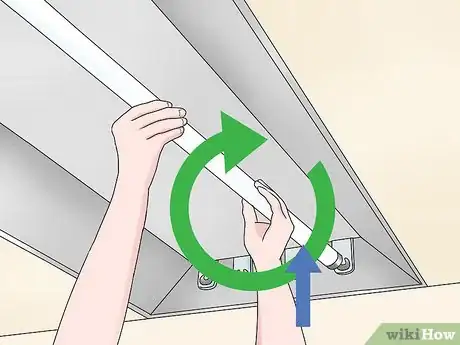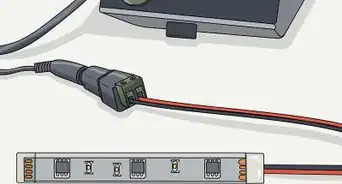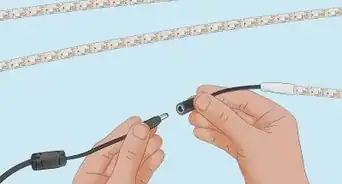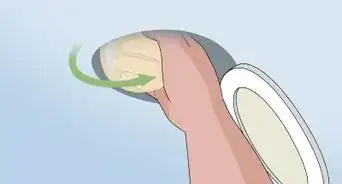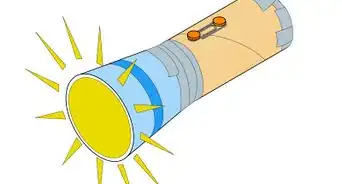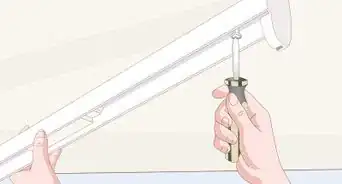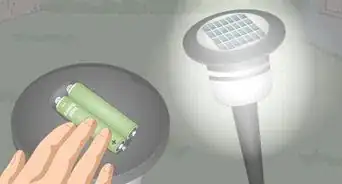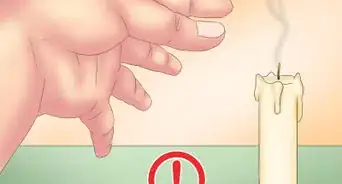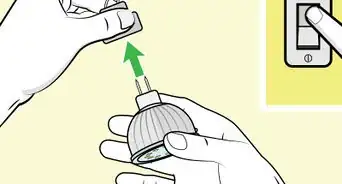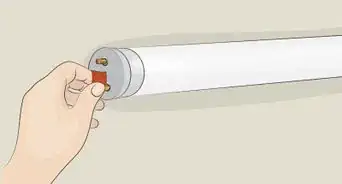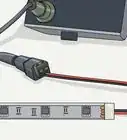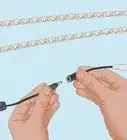This article was co-authored by Daniel Stoescu. Daniel Stoescu is a Master Electrician and the Owner and Operator of Home Tech Solutions, LLC in Hampton, Virginia. With over a decade of experience, Daniel specializes in wiring residential, commercial, and light industrial structures. The Home Tech Solutions team has over four decades of combined experience and offers comprehensive solutions for residential electrical needs.
This article has been viewed 561,900 times.
Changing a standard incandescent light bulb is, of course, the simplest of tasks. However, you may find yourself pausing when it comes time to replace a long, tube-style fluorescent lamp that is not immediately obvious how the bulb is removed from the housing. While it may seem intimidating, replacing fluorescent lighting can be simple.
Steps
Replacing the Bulb
-
1Make sure that the power is switched off. Before replacing a fluorescent light, you should make sure the fixture is not powered on. Do not simply use the wall switch to remove power to the fixture. You can use the fuse box to shut off power to the lamp's circuit. Use a voltage tester to verify that there is no power in the fixture.[1]
-
2Prepare a stepladder or other support. Most likely, you will not be able to reach the fluorescent light fixture comfortably from ground level. Position a stepladder underneath the fixture to replace the lamps comfortably and safely.[2]Advertisement
-
3Rotate the first tube 90 degrees. Reach up, and gently support the first fluorescent tube with both hands, keeping your hands as close to the ends of the bulb as possible. You will be able to rotate the tube in either direction a quarter-turn until it stops. This action rotates the prongs, that project from each end of the bulb, to a vertical alignment, and so allows you to slide the tube downward and out of the fixture.
-
4Gently lower the fluorescent tube straight down through the slot. Place the tube gently out of the way, where it cannot roll or be disturbed.
-
5Lift the new fluorescent tube into place. To install the new light, line its prongs up with the slots in either socket. Push the tube straight up into the sockets, and then rotate it 90 degrees until you feel it lock into place. You can give the lamp a gentle tug to ensure that it is firmly in place.[3]
- Consider installing LED lighting instead, which uses less energy, lasts longer, and produces a more natural light.
-
6Repeat this process with the other lamp. Most often, fluorescent light fixtures are designed with two tubes side-by-side. The process for replacing each tube is the same.[4]
-
7Test the new bulb. Flip the fuse box switch back on, then flip your wall switch on. See if the new fluorescent bulbs light up properly, noting that fluorescent lamps take a minute or so to reach full brightness. If the new bulbs do not work properly, you may have a defective component in your light fixture that needs to be replaced.[5]
Troubleshooting Problems
-
1Change out cracked sockets. Cracked sockets are often caused by other objects bumping into the fixture, or too much stress while removing a bulb. First, turn off the power to the light, and remove the bulbs. Keep the wiring order straight as you take out the old socket. It is important to cut only one wire lose at a time. Strip each wire back by 1/2 in., and put the stripped wire end into the terminal slots of the new socket. Do this for each wire.[6]
-
2Inspect the ballast. The ballast controls the amount of incoming voltage that start the light tubes. It also regulates the electricity to give constant light. If you believe that the ballast needs replacement, you may want to consider purchasing a whole new fixture. Ballast replacement may cost the same amount as a new fixture.[7]
- A humming sound produced by your fluorescent light fixture usually indicates that the ballast, rather than the bulbs, needs to be replaced.
-
3
Working with Office or Recessed Lighting
-
1Check for light frames. Office lighting is usually behind a bezel lens with a frame. These types of recessed fixtures are holding the light tubes in place to minimize accidents and breakage. They can be very frustrating due to the lack of wiggle room or freedom of movement. The frame is held in place by lever locks or snaps that you have to take out.
-
2Remove the cover. First, use a screwdriver to pry down the levers, while supporting the frame in the middle. It is important to support the frame because it can ruin the locks or swing down and hit you in the head.[10]
-
3Clean the fixture. Take the opportunity, while the lens is down, to remove insects, dust, condensation or mold from the lens surface.
-
4Take out the bulb. Depending on the bulb, you will either need to twist, or unsnap, each end of the fluorescent tube. Be sure to only do one end at a time to maintain more control over the bulb.[11] Once you wiggle the first tube out, the other tubes will come out much more easily.[12]
- Search for holes, or a recessed area, that the cathode/anode pin can sink into that permit freedom of movement.
-
5Lock in the new bulbs. To install the new light, line its prongs up with the slots in either socket. Push the tube straight up into the sockets, and then rotate it 90 degrees until you feel it lock into place. You can give the lamp a gentle tug to ensure that it is firmly in place.[13]
-
6Finish the job. When the last tube is in, swing the lens frame back in. Use both hands to support the frame in place. Then, use your thumbs to swing the frame lock back in.
- Snap locks may need to be pressed firmly to snap back in.[14]
Expert Q&A
-
QuestionHow do you remove a fluorescent light?
 Daniel StoescuDaniel Stoescu is a Master Electrician and the Owner and Operator of Home Tech Solutions, LLC in Hampton, Virginia. With over a decade of experience, Daniel specializes in wiring residential, commercial, and light industrial structures. The Home Tech Solutions team has over four decades of combined experience and offers comprehensive solutions for residential electrical needs.
Daniel StoescuDaniel Stoescu is a Master Electrician and the Owner and Operator of Home Tech Solutions, LLC in Hampton, Virginia. With over a decade of experience, Daniel specializes in wiring residential, commercial, and light industrial structures. The Home Tech Solutions team has over four decades of combined experience and offers comprehensive solutions for residential electrical needs.
Master Electrician Turn the power off and apply downward pressure at the end of the bulb. Keep in mind that circular fluorescent bulbs may shatter easily.
Turn the power off and apply downward pressure at the end of the bulb. Keep in mind that circular fluorescent bulbs may shatter easily. -
QuestionWhat is a fluorescent starter?
 wikiHow Staff EditorThis answer was written by one of our trained team of researchers who validated it for accuracy and comprehensiveness.
wikiHow Staff EditorThis answer was written by one of our trained team of researchers who validated it for accuracy and comprehensiveness.
Staff Answer wikiHow Staff EditorStaff AnswerA fluorescent starter is a timed switch. It lets the current flow through the filaments, which are located at each end of the fluorescent light tube.
wikiHow Staff EditorStaff AnswerA fluorescent starter is a timed switch. It lets the current flow through the filaments, which are located at each end of the fluorescent light tube. -
QuestionHow do you change a light ballast?
 wikiHow Staff EditorThis answer was written by one of our trained team of researchers who validated it for accuracy and comprehensiveness.
wikiHow Staff EditorThis answer was written by one of our trained team of researchers who validated it for accuracy and comprehensiveness.
Staff Answer wikiHow Staff EditorStaff AnswerChanging a light ballast is an involved process, so it’s important to follow step-by-step instructions that explains exactly what to do. Be sure the replacement used is of the same technology. It is suggested that you read all of this wikihow: How to Replace the Ballast in a Fluorescent Lighting Fixture, including its warnings, so you know what to do correctly.
wikiHow Staff EditorStaff AnswerChanging a light ballast is an involved process, so it’s important to follow step-by-step instructions that explains exactly what to do. Be sure the replacement used is of the same technology. It is suggested that you read all of this wikihow: How to Replace the Ballast in a Fluorescent Lighting Fixture, including its warnings, so you know what to do correctly.
Warnings
- Broken light bulbs pose a risk of eye and skin injury. Wearing safety glasses when replacing a bulb will help reduce the risk of eye injury in case of a breakage.⧼thumbs_response⧽
- Fluorescent bulbs of all types contain a small amount of mercury, which means they pose a health risk if broken. If you break a fluorescent bulb, open a window for ventilation and sweep the broken pieces into a container you can reseal for disposal.⧼thumbs_response⧽
Things You'll Need
- Stepladder
- Fluorescent bulbs
- Safety glasses
References
- ↑ Daniel Stoescu. Master Electrician. Expert Interview. 21 June 2021.
- ↑ Daniel Stoescu. Master Electrician. Expert Interview. 21 June 2021.
- ↑ Daniel Stoescu. Master Electrician. Expert Interview. 21 June 2021.
- ↑ http://www.familyhandyman.com/electrical/fluorescent-light/how-to-replace-a-fluorescent-light-bulb/view-all
- ↑ Daniel Stoescu. Master Electrician. Expert Interview. 21 June 2021.
- ↑ http://www.familyhandyman.com/electrical/fluorescent-light/how-to-replace-a-fluorescent-light-bulb/view-all
- ↑ http://www.familyhandyman.com/electrical/fluorescent-light/how-to-replace-a-fluorescent-light-bulb/view-all
- ↑ http://www.familyhandyman.com/electrical/fluorescent-light/how-to-replace-a-fluorescent-light-bulb/view-all
- ↑ http://www.familyhandyman.com/electrical/fluorescent-light/how-to-replace-a-fluorescent-light-bulb/view-all
- ↑ http://www.hgtv.com/design/decorating/clean-and-organize/replacing-a-fluorescent-light-fixture
- ↑ Daniel Stoescu. Master Electrician. Expert Interview. 21 June 2021.
- ↑ http://www.hgtv.com/design/decorating/clean-and-organize/replacing-a-fluorescent-light-fixture
- ↑ http://www.hgtv.com/design/decorating/clean-and-organize/replacing-a-fluorescent-light-fixture
- ↑ http://www.hgtv.com/design/decorating/clean-and-organize/replacing-a-fluorescent-light-fixture
- Videos provided by Total Lighting Supply
About This Article
To replace fluorescent lighting, locate the fuse box and shut off the power. If the light is overhead, position a sturdy stepladder underneath the fixture, then reach up and support the tube with one hand while you rotate it 90 degrees with your other hand. Next, slide the tube out of the fixture and put the tube aside. Lift the new fluorescent tube into place and line its prongs up with the slot on each end of the socket. Push the tube straight up into the sockets and rotate it 90 degrees until you feel it lock into place. If you want to learn how to remove frames covering your lights, keep reading the article!















